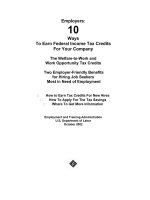SEVEN WAYS TO SAY GOODBYE TO A TRADE
Bạn đang xem bản rút gọn của tài liệu. Xem và tải ngay bản đầy đủ của tài liệu tại đây (90.57 KB, 8 trang )
SEVEN WAYS TO SAY GOODBYE TO A TRADE
By Brian Shannon
In the July 2003 issue of SFO Magazine I wrote an article that explored the dynamics of a
short squeeze and the factors that should be considered when entering a stock trade from
the long side. In this article we examine the elements that should be considered when
exiting a trade. Referring back to the stock outlined in July (good potential short squeeze
candidate Odyssey Healthcare), we will see where that trade should have been exited
using a timeframe appropriate for position traders (1 week to 6 months typically). We
will also study when the appropriate time is to exit a swing trade (1 to 10 days typically),
as well as looking at a unique way of exiting a profitable day trade.
It is often said that entering a stock is easy, but knowing when to sell (or cover a short) is
what separates the best traders from those who just scrape by. Any successful trader
knows that having an exit strategy is the true key to consistent success in the markets. As
with any decision in the market, it is easy to let emotions creep into the decision making
process. If a trader allows feelings to become a factor in making decisions, he will find
the emotional battle from within paralyzing at times. Some of the questions that will
creep into our minds include, “Do I sell now and take a small loss, or do I buy more to
average my price lower?” and “Should I sell for a small profit, or should I hold out for
bigger gains?” These are just a few of the questions traders ask themselves when faced
with a decision to close out a trade. Clearly these emotions are going to get in the way of
making objective decisions, so we must have a disciplined and consistent plan of action
that cuts losses at an early stage and allows our profits to run. This plan of action is based
on the single most factor, price action. In reality, knowing when to exit a position can be
an agonizing experience to the undisciplined trader, especially when trading larger share
size.
Traders must recognize that the market does not care what any of us think the stock
should do. At the end of the day, our opinion does not count. Buying or selling a stock
casts our vote of confidence for that security, and in the market our opinion is about as
relevant as if we had voted for Al Gore for President. Therefore, we must always
remember to leave our egos at the door and trade according to price action, not what we
believe.
With that in mind, when should a position be covered? Professionals trade according to a
plan that is thought out in advance and based on market action. The only accurate way to
measure whether a stock is behaving as it should is by studying technical analysis.
Technical analysis allows us to be completely objective in our assessment of price action
and allows us to leave emotion out of the decision making process. Knowing when to
cover a trade is accomplished by letting the stock tell us when to get out. You might be
thinking “How the heck is the stock going to ‘tell me’ when to cover”? The answer to this
question is more straightforward than you would imagine, and it relies on simple
technical concepts.
Before we get to specific strategies, it is important to consider the futile nature of trying
to find the single best way of exiting a position. We need to recognize that there is no
single best way to do anything in the market because we all have different objectives in
terms of time in a trade, different risk tolerance, as well as funds within our account. We
also have to take into consideration that a successful trader will often implement multiple
strategies encompassing different timeframes and varying objectives in the same account
to gain a diversification in his income stream. Certainly the objectives of someone who is
a pure day trader will be vastly different than those of a more patient individual who may
be comfortable holding a position for months at a time. With that in mind, we will
examine seven good reasons and strategies to exit a position. By having a solid
understanding of these seven incidents of market action, we are in a position to sell based
on an objective interpretation of the message the market relays to us in the form of a price
chart. For simplicity we will refer to the long side of the market in all of the examples;
however, it is important to recognize that these events are valid on the short side by
simply reversing the rules.
There are seven events that should motivate you to sell. These events can be best
described as:
Initial Protective Stop
Gaps against the prevailing trend
Price Targets
Hard Trailing Stops
RealTick ® Trailing Stops
Moving Average Crossovers
Time Stops
Initial Protective Stops give us our first decision to sell because they are based on the
interest of preservation of capital. Before we ever think about taking profits, we have to
ensure that we are in a profitable position. Long before we are in a profitable position our
stock has to pass an initial test of strength. The nature of short-term trading is to be in a
position only while the stock is showing positive momentum. Positive momentum means
that the stock is moving in the direction we anticipated (we can have positive momentum
in a stock that is dropping if we are short the stock). Once a stock shows signs of
reversing its momentum, swingtraders should be out of that position and in cash, or else
in another stock where their money is working for them
The final judge as to the success or failure of a trade is price, and it is therefore the most
important consideration in when to exit a position. Price action is the building block upon
which support and resistance are formed, becoming the bedrock of trends. The goal of a
trader is to capture as much of a trend as the market allows for, and this is why price is
our most important source of information. The first time that price plays a role in our
decision making process is in setting an initial protective stop on the position. Before
thinking about how much money a trade will make, we need to consider where we will
exit if the trade does not go according to plan. By having a protective stop on a trade, we
will not succumb to holding a position because we “think it is a good idea”. Removing
the emotion from the decision making process allows us to be completely objective in our
analysis of the progression of the trade.
When initially entering the trade, the first technical consideration is the location and price
levels of support and resistance. Besides making sure we are entering a position that is
not too far extended from a decent level of support, the reason we immediately look for
support and resistance is to set a protective stop. We place the initial stop to make sure
that if the stock does not act the way we expected it to, our accounts are not exposed to a
catastrophic loss. For longs, stops should be placed just below the most recent support,
and for shorts stops should be placed just above a recent resistance level. Obviously, if it
is not a swing trade, a shorter timeframe should be utilized to determine this protective
level. In the case of ODSY, the stock was shown after it broke out to all time highs on
May 6, with the price at the time $17.60 (adjusted for a 3/2 split on August 12). At that
time, the highest preceding low was found at the April 30- low of $15.73, coinciding with
the location of the rising 50 day moving average. Whenever we have more than one
technical reason for being involved in a trade it adds significance to the level. In this case
we had what appeared to be the beginnings of a new uptrend with the prior low and the
rising 50 day moving average in the same location. Just below the prior higher low is
often the ideal point to place our initial stop because breaking below that level would
nullify the trend. In essence, we are exploiting the definition of an uptrend (higher highs
and higher lows) to remove the dangerous emotions to be allowed to enter our decision
making process.
Gaps against the prevailing trend occur when a stock in an up trend suddenly gaps lower
while you have a long position in the stock. Luckily, these gaps in trading caused by an
imbalance to the sell side while the stock is in a solid up trend are not that common. We
are not discussing common gaps of 1-2% here, but a gap down by more than 5%. When
we do find ourselves in the unfortunate situation of being caught in this predicament, it is
often best to sell the entire position. A gap of this magnitude (5% or move) will not
typically occur unless there is a serious fundamental development at the company, and
since our entry may not have taken fundamentals into consideration, we are now in a
position that we were not anticipating. As they say, “When in doubt, get out!” As a
general rule of thumb for gaps, liquidate the position if a hard stop (sell event number 4)
has been violated. If the stock gaps down 5% but does not violate a hard stop, we need to
monitor the stock closely for further signs of weakness. If it looks like liquidity may be
an issue for exiting a larger position, it is a good idea to consider selling half of the
position so if the weakness continues you will not feel trapped in the stock as it declines
and grow reluctant to sell, waiting for a bounce that may never arrive.
We can see in the chart of RSA Security that the stock gapped lower on October 17 and
did not bounce. Although it would have been a tough decision to liquidate the position on
such a gap, it is clearly better to have sold at the first sign of trouble than it would have
been to continue to hold and hope. Sometimes it is best to get the pain over all at once by
selling the entire position rather than prolonging the agony of a loser, similar to removing
a band aid from a wound, as slowly peeling a band aid only extends the discomfort.
Price Targets. It is a good idea to have a reasonable expectation as to where you think the
stock has the potential to rally to; thus coming up with an estimated area where selling
may occur. If our stock is in a solid uptrend that may be approaching a prior level of
support, there is the potential for that past area of buying to offer resistance. Assuming
you started with a good theoretical risk/reward ratio in your original purchase, taking
some of the profits makes sense at the target area. But also be careful not to sell too much
of a stock that continues to have strong upward momentum because the biggest gains are
likely to still be ahead in this situation. Selling a little at the target also helps make it
easier to let go of the stock later because it shows we are not emotionally attached to the
stock, and you’ve got to admit it feels good to take a profit and reward yourself a little.
Taking a little stock off the position also reduces our overall risk and gives us a little
cushion in case something unexpected happens to make the stock drop suddenly. For the
rest of the position, hold on tight, and allow yourself to have a big winner. Bulls and
Bears make money, Greedy pigs get slaughtered and Disciplined pigs get Rich!
Hard trailing stops require the most skill, but by the time we get to this point, the stock is
doing the work while our job is to monitor and adjust our risk levels as the stock moves
higher. A hard trailing stop is based on the very definition of the trends we are trying to
take money from. As we know, the definition of an uptrend is “a series of higher highs
and higher lows.” This implies that breaking the series of higher lows is a violation of the
trend and that is a reason to sell. When looking at a chart that encompasses 17 days of
trading utilizing 15 minute time increments, we can see how shares of Netflix Inc.
(NFLX) ascended over the course of nine days in a perfect stair-step pattern of higher
highs and higher lows. Assuming the purchase of the stock at $36.50 on October 2nd, we
would have an unrealized profit of $4.41 per share based on the close at $40.91, and this
is a gain that is definitely worth protecting. The accompanying chart of NFLX shows
how the trader would have raised the stop up under the rising lows with an exit being
made on October 8th as the stock traded below the prior low of $42.85. This stop would
have allowed the trader to lock in a gain of $6.35 over the course of five trading days.
This stop takes some work because you have to cancel and replace orders, but this is
work that is fun because it means you are locking in profits. In order to capture the
occasional windfall profits in a stock that exceeds the profit objectives, we use a simple
methodology that has proven very effective for holding stocks that are showing positive
momentum. The method for allowing our winners to run is to use a trailing stop-loss
based on the higher lows that the stock is forming in the uptrend. Holding a long stock
that is moving higher is done by using the daily chart and placing our stop just below the
level of the last higher low. If the stock does not trade below the previous days low then
it is showing positive momentum and should be held overnight again.
RealTick® Trailing Stops are my favorite stops to use on a day trade. This unique stop
actually gives control of your order to the algorithm built into the RealTick trading
platform. The ideal situation to use a trailing stop is when you buy a stock that finds rapid
upside velocity, pushing the stock quickly away from your hard stop. In the situation
where the stock may run $1.00 or more in just a few minutes we are faced with the
dilemma of deciding whether to sell the position and lock in the gains or to allow it to run
further. We’ve all seen the stocks that can run 2-3 dollars in the course of an hour or less,
and we certainly don’t want to allow a nice winner turn into a loser. The emotions that
can be dredged up from this experience tempt event the most disciplined traders to exit
with the profit rather than allowing it to run further. These stops are going to be utilized
most often within the first hour of trading, when emotions from the amateur buyers are
often at an extreme. Fortunately, technology has taken given us the opportunity to
mitigate the emotional decision process with the Real Tick trailing stop.
This stop works in the following way, we will refer to chart four here. On August 21









